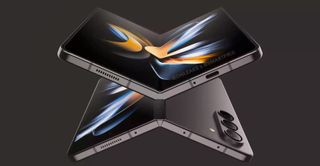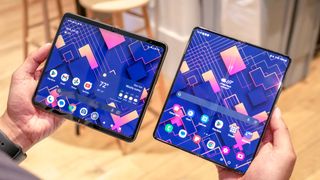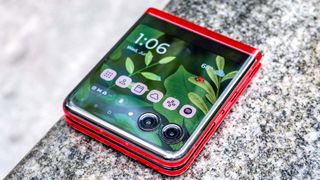Right now the overall phone market is in decline – about -14% according to the latest estimates – and Apple’s iPhone shipments are also down year-on-year by -2.3%. Yet the nascent foldable phone market continues to grow.
Analyst firm IDC forecasts foldable shipments to reach 21.4 million units in 2023, up 50%. And that the compound annual growth rate from 2022 to 2027 will be 27.6%, reaching 48.1 million units at that point. However, there are a lot of people who haven’t bought a foldable phone yet, and Apple’s iPhone Flip or foldable iPhone could be in another year or two.
Google recently joined the party with the Google Pixel Fold and Motorola made quite a comeback with its Motorola Razr+. But all eyes will be on Samsung with the Galaxy Unpacked event on July 26, where the company is expected to unveil the Galaxy Z Fold 5 and Galaxy Z Flip 5.
I asked three prominent analysts what they think Samsung needs to do to win over foldable skeptics and what’s next for this category.
What do you think Samsung can do to change people’s minds about owning a foldable phone with the Galaxy Z Fold 5 and Z Flip 5?
Nabila Popal, IDC: Samsung has done a fantastic job marketing its foldable devices, but since price is the primary concern for consumers, especially in this challenging economic climate, faster adoption can be sparked by offering higher trade-in values, financing, and after-sales services. – discounted assistance.
Samsung is now in its fifth generation and needs to get consumers excited about how iterative improvements over the years have resulted in some pretty cool devices today.
Avi Greengart, Techsponential
Avi Greengart, Technical Representative: Samsung is now in its fifth generation and needs to get consumers excited about how iterative improvements over the years have resulted in some pretty cool devices today. Samsung’s long investment in the category has produced foldables that are durable and refined, so consumers who have been on the sidelines can actually feel comfortable jumping in now.
Carolina Milanesi, Creative Strategies: Selling the Z Flip remains the easier task as the price is much more attractive to consumers and concerns about durability aren’t as strong as they once were. I think the Fold’s price remains steep for most consumers because the return on investment may not be as clear-cut for those who don’t think they have a business need for the additional screen.
What are the biggest barriers to folding adoption? Price, compromised features or something else?
popular: Price is definitely the biggest barrier to mass adoption as still nearly 80% of smartphones shipped globally are below $800. However, I don’t think that’s a bad thing as premium phones allow OEMs to achieve higher profits and this is a new form factor that I believe deserves to position itself as a premium product.
Greengart: There are really two of them: price and ecosystem. The Flip’s price isn’t a major obstacle for premium smartphone buyers, but the Fold is still a major investment. Samsung is seeing much higher migration rates from Apple to its foldable devices than its other phones, but there are certainly still a lot of people who are happily stuck in the Apple ecosystem.
Milanese: I still believe the addressable market for the flip form factor is much bigger not only because of the price, but also because there isn’t a learning curve to using the device and getting the most out of it. For the Fold, more intentionality is needed, and I think the target market is quite similar to that of the Galaxy Note: an audience first for productivity.
What is your opinion on Google Pixel Fold and Motorola Razr+ and how important is it to offer consumers more choice?
popular: They’re both great devices, but their limited global presence makes it difficult to give Samsung enough competition in the foldable space. Samsung has a 65% share of the global foldable market, followed by OPPO and Huawei in second and third place.
When we see some of the reviews for the Pixel Fold, there is also the risk created by new entrants that they may have technical issues that don’t help consumers gain confidence in the segment as a whole.
Carolina Milanesi, Creative Strategies
Greengart: Samsung has the strongest branding, the most refined user experience, and is not challenged on price. Samsung couldn’t have the market to itself forever, and I suspect competition will grow the market to Samsung’s benefit more than any loss of sales to rivals. That said, Motorola’s Razr+ is a amount of fun.
Milanese: The choice for consumers is always great and while we don’t see them here in the US, brands like Oppo have entered the market already putting some pressure on Samsung’s prices. At the same time, when we see some of the reviews for the Pixel Fold, there is also the risk created by new entrants that they may have technical issues that don’t help consumers gain confidence in the segment as a whole.
Do you think it will take Apple to create a leaflet to legitimize this segment? Do you think we’ll see a foldable iPhone?
popular: The foldable segment is not a fad as many thought a few years ago. It is a legitimate trend and destined to remain. According to IDC’s latest forecast foldout, we expect this segment to grow over the long term, with or without Apple. However, surely if and when Apple enters this segment, it will create huge momentum for this form factor and greatly accelerate the penetration of foldables into the smartphone space.
Greengart: Foldables are already a legitimate premium smartphone category for everyone but Apple users. As long as sales volumes remain relatively small, Apple will wait, but as we’ve seen with large screens, once large-scale demand is demonstrated, Apple will enter the market.
Milanese: I’m not sure we’ll see a foldable iPhone anytime soon. I still argue that Apple may make a foldable iPad before they make a foldable iPhone. Apple has a phone to address the entire market, and I think it’s too early to move the Pro Max to a foldable design.
More from Tom’s Guide
#Galaxy #Fold #Flip #Samsung #convince #buy #foldable #phone
Image Source : www.tomsguide.com



